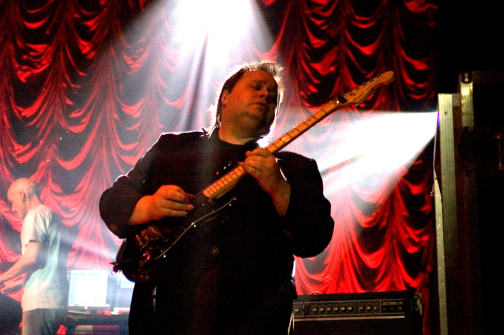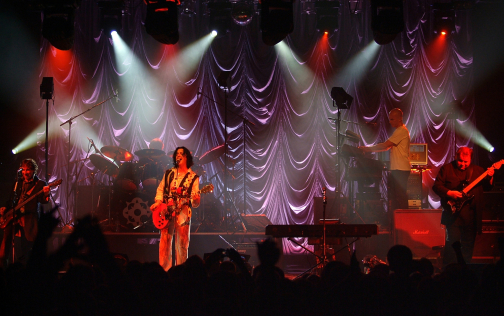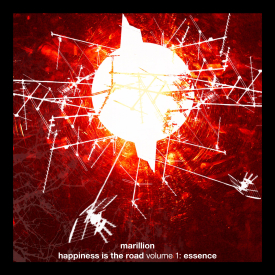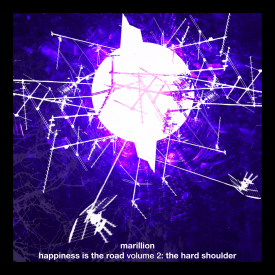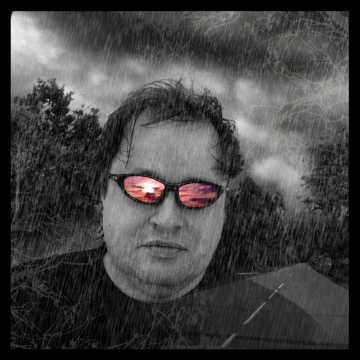Marillion’s Steve Rothery on “Happiness Is The Road”
Do you remember your first math class? After being introduced to the wide world of numbers, you began learning that 1+1 = 2; 2+2 = 4; 2+3 = 5; 6 +3 = 9 and so on. As well, it didn’t matter if you wrote 2+3 or 3+2, the answer is still five. This is known as the commutative property of addition. But for some entities, 1+1+1+1+1 doesn’t equal 5 no matter how it’s written!
Such is the case with British band Marillion, when whose five individual members – vocalist Steve Hogarth, guitarist Steve Rothery, bassist Pete Trewavas, keyboardist Mark Kelly and drummer Ian Mosley – come together, they ”add” up to something more than 5. As guitarist Steve Rothery confirms, “It’s how you can put five musicians in a room, and the sum of the parts is so much greater than you’d expect.”
Such expectations have helped keep Marillion on a singular artistic journey for nearly 30 years. When many of the band’s contemporaries have called it a day, fallen back on greatest hits or just failed to keep up with the ever-changing “music” industry, Marillion have not only persevered but have seemingly thrived, thanks to a fiercely devout fan base, a willingness to embrace change and an absolute dedication to craft.
By anybody’s count, Marillion have been a busy band. By the time they released 2007’s Somewhere Else, the band had already written enough material for another album, and at the end of October 2008, unleashed the double-CD set Happiness Is The Road, Volume 1: Essence & Volume 2: The Hard Shoulder (my complete review can be seen on the pages of Goldmine magazine).
Happiness Is The Road is a musical pastiche, representative of what Marillion do so well, from the prog-rock frontiers of “The Man From The Planet Marzipan” across the broad sweep of “Essence” to the rumbling “Thunder Fly.” Happiness can be seen as a statement of purpose, not just for the band members but for their fiercely devoted fans, as well. It’s also an aural delight, an unbelievably rich sonic experience that reveals more detail with every listen.
Marillion guitarist Steve Rothery spoke to ClassicRockMusicBlog about the Happiness Is The Road, getting the right sounds, Marillion fans, his upcoming solo project and more.
Congratulations on the new album. Both discs are great.
Yeah, well it’s a pleasure. The new album turned out really well. At this point, when you’ve made so many records you’re always in danger of repeating yourself, but it turned out good.
There’s a lot going on here sonically, and I don’t think you can get the full impact of the music without hearing it on a good stereo system or through headphones.
Oh definitely – it makes all the difference. I think sonically, it’s probably the best-sounding record we’ve ever made. And I think if you hear it on a good system, that really does come across.
It has a real depth and richness. Did it take a lot of effort to get that sound?
Probably more [producer] Mike Hunter than ourselves. The main technical difference is that it’s the first time we recorded a record at a high bit rate and a high sample rate – 24 bit 96 kHz. It’s quite a subtle difference, but there’s a crispness that you get – especially at high frequencies. But even when it’s dithered down to 16 bit for CD it still retains some of that extra clarity, I think.
The piano and bass sometimes sound like they’re right in your room.
Yeah, definitely. I think Mike did a really good job. He’s a brilliant engineer, and a lot of the credit for the record has to go to him – from an engineering point of view. We were always in a state of recording when we were doing the writing for this record, so if something great happened in the room it was then possible to use on the record. One of the most difficult things is you’ve got an idea – and you’ve got it demoed as a stereo file – and then trying to re-create these subtle nuances, grooves… even sometimes the sound that you use. It’s never quite the same, so the more of the original magic you can use, the better.
Aside from writing the material itself, were there any specific musical challenges with this record?
Really, it’s about not repeating yourself. You try to write something fresh and interesting to bring to a record. I think it has to be a sound you’ve probably heard before, but it’s more like an approach or a sensibility, really. You don’t want to sound too current. It’s better to have a timeless quality instead of trying to sound like everybody else’s records.
What makes Marillion work so well?
The magic that we create is very much down to the interaction between the five of us. That starts in the writing stage – sometimes someone will come up with a very basic idea, but how the idea bounces around the room and grows and evolves is the thing, I think, that sets us apart from a lot of other bands. We harbor that chemistry, I suppose. In terms of who writes what, that tends to change from track to track and from album to album. Sometimes I’ll come in with an idea; sometimes it’s Mark or Steve or Pete. It’s how you can put five musicians in a room, and the sum of the parts is so much greater than you’d expect.
My thing is, it’s always down to what the song requires – the way I approach playing the guitar and writing, really, is listening to what’s happening, and tuning into the magic in the room and deciding what’s the best part to play here. Sometimes it’s more about the right choice of sounds and atmospheres as opposed to any overly technical approach.
What guitar parts or solos are you particularly proud of?
I really like playing “This Train Is My Life” and “Asylum Satellite #1.”
Those are actually my two favorites. How did you get the guitar sounds on “Asylum Satellite”?
My main guitar is a Blade, a Blade Stratocaster. On that song, I use a Hughes & Kettner Rotosphere, which is kind of like a Leslie-type effect. It gives it a great, sort of, warble. I use various amps and sound boxes. My main amp is a Groove Tubes Trio preamp and a 275 power amp. That’s kind of what I’ve used on the all the albums since Anoraknophobia. There’s various bits of equipment, but there are some that are my first choice, and the Rotosphere is one of them. The other one is the Roger Linn AdrenaLinn pedal, which I use quite a lot on the new record. Some stuff that you might think are keyboards is the guitar through this pedal – that’s a really, really cool pedal. You can synch up to MIDI, so when we do these backing tracks – they’re usually to a tempo map – so it’s giving you this fantastic groove and atmosphere, just right in the pocket of the rhythm. That’s in the writing and recording stage. It’s a great box.
And “Asylum” has that real spacey sound, too.
Yeah. It’s always a great one to play live, as well. It’s a point in the set where I can actually just improvise. Every night it’s different. Some nights it’s great [laughs], other nights maybe not so great. There’s always sort of a moment of danger and panic when you get to the point where you really don’t know what you’re going to play next. [laughs] It’s good. It keeps me awake. [laughs]
Steve Hogarth writes all the band’s lyrics, and he keeps getting better with each album. Do you or the other guys make suggestions about the words he presents, or do you just leave them alone?
We pretty much leave them alone. If there’s something that he writes that we don’t like, we’ll usually say so, or tell the producer so he can tell him. [laughs] You don’t want to upset the singer – they’re such fragile creatures. [laughs] We share so much in terms of what we think is great – both musically and lyrically – that’s almost never been a problem. Yeah, I do think Steve writes some amazing words. In a way, the next record’s going to be quite a challenge for him because he’s kind of used an awful lot of what we’ve had on the shelf for the last couple of albums. So, yeah, he needs to go traveling the world for six months, I think, to write another album’s worth. [laughs]
The first disc opens on a very quiet note with “Dreamy Street,” more like a musical miniature. What’s the process for how the songs were sequenced?
That really only comes about in the later stages, once the album has sort of taken shape. We try different running orders, and we had the luxury with this album of having two different albums to choose which songs make the most coherent statements on each record. They almost choose themselves to a certain extent – it’s incredible when you’ve found the running order, and after awhile it’s the only way you can imagine. That wasn’t the case until about a month before the record was finished.
I think “Essence” is the track from these two discs. Could it be the ultimate Marillion song?
The ultimate Marillion song – that’s hard to quantify, really. I think it’s a great song. There’s a lot of great songs on both the albums. I don’t know if it’s the best Marillion song ever – that’s hard to say. In the same way, is it the best Marillion album ever? For some people, Afraid Of Sunlight is the strongest collection of individual songs we’ve ever done. Some people like Brave; some people like Marbles. This album has had amazing reviews all around the world, so I think it’s up there, but any particular song comes down to personal choice of favorites.
I think it’s a great song. “This Train Is My Life,” “Asylum Satellite #1,” and “The Man From The Planet Marzipan,” “Happiness Is The Road” and “Essence” are probably my favorites.
“Thunder Fly” has a great groove.
It’s good. It’s something different for us, having that slightly Doors-y intro. It’s cool; it’s a fun track to play.
The instrumental “Liquidity” is another favorite of mine. It’s got a very spiritual, almost hymn-like feel. It’s beautiful.
Yeah. It’s one of Mark’s [Kelly] pieces. During the writing of the record, we all got to do our own bits and pieces. It’s one of the things Mark came up with. It’s a lovely piece of music.
The title track, “Happiness Is The Road,” took me awhile to get. The opening keyboards remind me of Brian Eno and his ambient works, but now I can’t imagine the song without it. Are there songs that take time to sink in for you and fully appreciate?
Sometimes it’s only when you’ve toured a song that you can get inside its skin. You can play a song as you’re writing it and not really get it yourself. I think it’s only with time, sometimes, does it kind of make sense. The more you play a song live, the more you explore it in a way – you find the little nuances and subtleties to add to it. Once you take that song out in front of a live audience you still evolve it further to a certain extent.
By doing that, can you get close to hearing a song from a fan’s perspective?
I don’t know that you can ever hear it from a fan’s perspective – you’re too inside it. Your own perspective of your own music is always that kind of viewpoint where you’re looking at it through the other end of the telescope. [laughs] It’s a curious thing, really. Sometimes you can sit back and enjoy your music and kind of listen to it, but quite often you’ve heard those songs so many times – you’ve played them so many times, especially by the end of the three-month tour. You need a bit of time away from it to actually be able to absorb it in that kind of third-party manner.
You’ll soon be doing the Marillion fan weekend shows, which require presenting a huge amount of material. How do you remember six or seven hours worth of music?
[laughs] It takes a lot of hard work. It’s like your brain can only hold so many songs, especially when you reach a certain age it becomes increasingly harder to remember things. [laughs] But we do pretty well. I think it was harder for the last conventions we played because we each chose two songs, and some of those were a bit obscure – there was quite a lot of homework involved.
I wanted to touch on the Somewhere In London DVD. The audience participation during those shows is incredible.
I think we have probably one of the best audiences in the world, really. People who get this music, totally get it. It’s not just, “Hey, I’ve got something to listen to while I do something around the house.” It’s music that really absorbs you, and you tend to find that the people who come to the conventions are like a distillation of the people that feel the strongest, almost, about what you do – and at the concerts, as well. It’s just a great, great audience that we have. There’s not many bands that I’ve seen that have anything approaching that level of response and respect that we get from our audience.
There’s some remarkable footage at the end of the DVD where someone requests “Sugar Mice,” then you switch guitars and start playing, and the audience sings the entire song like one giant voice. And then you go into “Easter,” and the response is the same. It’s very moving.
I know. It’s absolutely amazing. We have a great audience. On the last tour we did there was a lot of great shows, but there were probably three that were absolutely mind-blowing – that we’ll always remember. And to still have that after touring for 27 years – since we first recorded for EMI – to still get that sort of response is an amazing achievement, I think.
Did you collect records growing up?
Yeah. I mean, I didn’t have that much money – I spent most of it on guitar strings, probably. But, yeah, I had the Pink Floyd albums and various other artists: Camel, Genesis and some others.
Was there a particular record or song that made you want to play guitar?
Yeah. I always wanted to be a musician, but when [Pink Floyd’s] Wish You Were Here came out – listening to that on the beach in Whitby – a small fishing town on the northeast coast of England, where I grew up – I thought, “This is it. This is what I want to do with my life”: to create something that magical. So, yeah, that’s kind of when I decided what I wanted to do with my life.
If you could take one year off from Marillion and pursue a specific guitar interest or style, what would you do?
I honestly don’t know. A year off from Marillion, ah that’s a joke. [laughs] I do other things outside the band. I’m just finishing up a project called The Wishing Tree, with a female singer [Hannah Stobart]. And that stylistically is quite different than Marillion. That’s something I wanted to do – I’m doing everything now. I’m playing keyboards and bass, and I’ve recorded it, produced it and arranged it. It’s been a huge amount of work, and there was quite a big learning curve for me. Any time outside the band, what I would probably do is find an artist, somebody to work with, and take a project and try to develop it.


